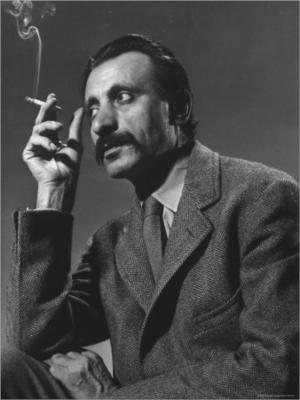There are many cases in the history of arts and letters when an artist who has been engulfed by a tragic life becomes posthumously famous. Such has been the case of perhaps one of the most celebrated Armenian names in American and world painting: Arshile Gorky.
The future painter was born Vostanik Manoug Adoian in the village of Khorkom, in the district of Hayots Dzor (Van), on April 15, 1904. He received his elementary education in the village school and in Van. His father migrated to the United States in 1908 to avoid military service in the Ottoman army, leaving his family behind. In 1915, after the self-defense of Van and following the massive Armenian migration as a result of the retreat of the Russian army, young Vostanik followed his mother Shoushanig Der Mardirosian and his three sisters as refugees first in Echmiadzin and then in Yerevan. He continued his studies at the diocesan school of Yerevan, where he studied painting and wood engraving. His elder sisters left for the United States in 1916, and three years later his mother died of starvation in Yerevan. In 1920 Vostanik and his other sister moved to Tiflis (Tbilisi), and then to Batum, from where they embarked to the United States. He reunited with his father when in America, but they never got along.
In 1922 Vostanik Adoian entered the New School of Design in Boston, where he also became a part-time instructor. In 1924 he took the name Arshile Gorky, portraying himself as a Georgian noble (Arshile is a Georgian name) and even as a relative of Russian famous writer Maxim Gorky. In the same year he moved to New York, where he taught at the Grand Central School of Art from 1925-1931. In the 1920s he went from impressionism to post-impressionism and, after a cubist period, he finally found his way of expression through surrealism.
In 1933, during the days of the Great Depression, Gorky was one of the first artists employed by the Works Project Administration (WPA) Federal Art Project. He was commissioned to paint ten large panels with the theme of aviation at the Newark airport (New Jersey), which he completed between 1935 and 1937. In 1935 he married Marny George, whom he divorced the following year.
Gorky’s original paintings, suffused with an impressive use of color, later were hailed worldwide and considered among the pioneering works of abstract expressionism. Among them we can mention the series “Garden in Sochi” (1938), “How My Mother’s Embroidered Apron Unfolds in My Life” (1944), the series “The Plough and the Song (1944-1947), and many others. Perhaps the most famous and popular work is “The Artist with His Mother” (1926-1932). His childhood and the Armenian genocide are considered impactful events not only in his life, but on his creation.
In 1941 Gorky married again, this time to Agnes Magruder (whom he nicknamed with the Armenian term of endearment Moogooch), and they had two daughters, Maro and Natasha. They moved to Roxbury (Connecticut) in 1945, but in 1946 he had to confront several tragic events: first his studio, 36 paintings, and library were devoured by a fire; then, he had a colostomy for cancer, and finally his wife had an affair with Roberto Matta, a prominent Chilean painter. The crisis in his life continued unabated.
Following a car accident in 1948, Gorky’s neck was damaged and he was temporarily incapacitated to use his painting arm. His wife abandoned him, taking his daughters with her. The painter could not endure so many calamities in his life, and on July 21, 1948 he committed suicide in Sherman (Connecticut). He was buried in the local North Cemetery. It would take decades until he was hailed as one of the most prominent names of twentieth century American painting and an iconic name in Armenian reality.
Previous entries in “This Week in Armenian History” are on the Prelacy’s web site (www.armenianprelacy.org).

